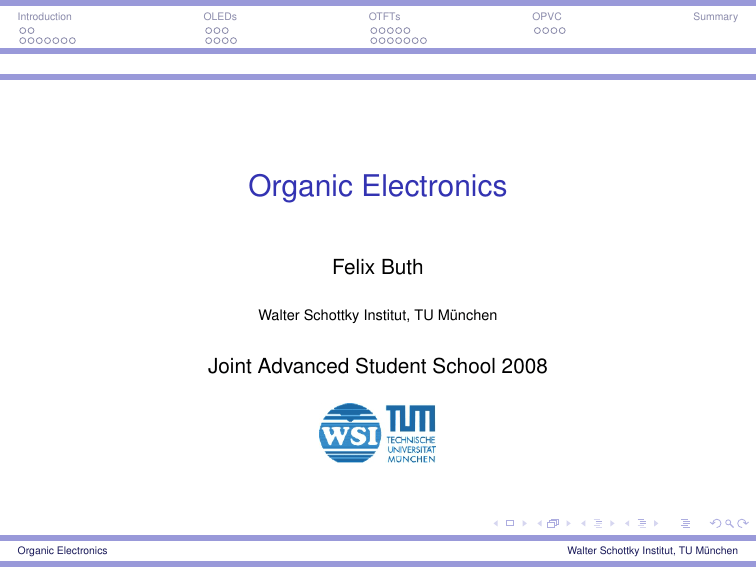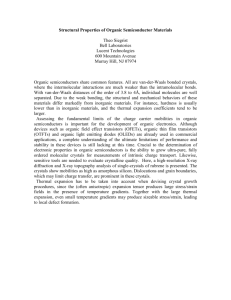Organic Electronics
advertisement

Introduction
OLEDs
OTFTs
OPVC
Summary
Organic Electronics
Felix Buth
Walter Schottky Institut, TU München
Joint Advanced Student School 2008
Organic Electronics
Walter Schottky Institut, TU München
Introduction
OLEDs
OTFTs
OPVC
Summary
Outline
1
Introduction
Difference organic/inorganic semiconductors
From molecular orbitals to the molecular crystal
2
Organic Light Emitting Diodes
Basic Principals
Multilayer OLEDs
3
Organic Thin Film Transistors
OTFT Structure
Transport in organic semiconductors
4
Organic Photovoltaic Cells
Differences to inorganic solar cells
5
Summary
Organic Electronics
Walter Schottky Institut, TU München
Introduction
OLEDs
OTFTs
OPVC
Summary
What is organic electronics?
Electronics with carbon-based materials
Two different groups:
Small-molecular materials
Pentacene
Anthracene
mainly prepared by thermal evaporation
Polymers
Polythiophene (PT)
Polyphenylen-vinylene (PPV)
prepared by solution processing (spin-coating, inkjet printing)
Organic Electronics
Walter Schottky Institut, TU München
Introduction
OLEDs
OTFTs
OPVC
Summary
Organic vs inorganic Semiconductors
Advantages of organic semiconductors
Light weight
Mechanical flexibility
Chemical modifications
possible
Easy and cheap
processing (e.g. ink-jet
printing, spin coating)
Readius from Polymer Vision
Organic Electronics
Walter Schottky Institut, TU München
Introduction
OLEDs
OTFTs
OPVC
Summary
Organic vs inorganic Semiconductors
Disadvantages of organic materials
Poor cristallinity
Low mobility =⇒ low speed
of devices
Possible degradation under
environmental influences
Dark spots on a ITO/α-NPD/Alq3 /Al OLED from: Kim et al.
Appl. Phys. Lett. 89, 132108 (2006)
Organic Electronics
Walter Schottky Institut, TU München
Introduction
OLEDs
OTFTs
OPVC
Summary
Electrical Properties
Molecular Orbitals
Interaction between the atomic orbitals leads to bonding and
anti-bonding molecular orbitals
Splitting determined by the interaction between the atoms
Organic Electronics
Walter Schottky Institut, TU München
Introduction
OLEDs
OTFTs
OPVC
Summary
Electrical Properties
Physical Dimers
Special arrangement of two molecules close to one another,
without the formation of chemical bonds
Described by the following Hamiltonian: H = H1 + H2 + V12
where H1 and H2 are the Hamiltonians of the isolated molecules
and V12 describes their interaction
Organic Electronics
Walter Schottky Institut, TU München
Introduction
OLEDs
OTFTs
OPVC
Summary
Electrical Properties
Ground States of a Physical Dimer
Approximation of the ground state wavefunction as the product of the
two molecular states:
Dimer Ground State
Ψg = Ψ1 Ψ2
The resulting energy of the ground state is the sum of the two
molecular states, but shifted by the coulombic binding energy W :
Ground State Energy
Eg = E1 + E2 + < Ψ1 Ψ2 |V12 |Ψ1 Ψ2 >
|
{z
}
W
Organic Electronics
Walter Schottky Institut, TU München
Introduction
OLEDs
OTFTs
OPVC
Summary
Electrical Properties
Excited States of a Physical Dimer
First Excited State (case of identical molecules)
ΨE =
√1
2
(Ψ∗1 Ψ2 ± Ψ1 Ψ∗2 )
Excited State Energy
E ± = E1∗ + E2 + < Ψ∗1 Ψ2 |V12 |Ψ∗1 Ψ2 > ± < Ψ∗1 Ψ2 |V12 |Ψ1 Ψ∗2 >
|
{z
} |
{z
}
W0
Organic Electronics
β
Walter Schottky Institut, TU München
Introduction
OLEDs
OTFTs
OPVC
Summary
Electrical Properties
Linear Molecular Crystal
For not only two molecules but
a linear array of N benzene
rings, one gets the following
energy levels:
Organic Electronics
Walter Schottky Institut, TU München
Introduction
OLEDs
OTFTs
OPVC
Summary
Electrical Properties
Excitons
Binding energy in inorganic semiconductors: 1-40 meV
in organic materials: 100-300 meV (→ stable at 300K)
Organic Electronics
Walter Schottky Institut, TU München
Introduction
OLEDs
OTFTs
OPVC
Summary
Electrical Properties
Comparison Germanium and Anthracene
Melting point[◦ C]
1
]
Intrinsic conductivity @ 300K [ Ωcm
cm2
Electron mobility @ 300K [ Vs ]
2
Hole mobility @ 300K [ cm
Vs ]
Organic Electronics
Germanium
937
0.02
4500
3500
Anthracene
217
≈ 10−22
1.06
1.31
Walter Schottky Institut, TU München
Introduction
OLEDs
OTFTs
OPVC
Summary
Basic Principals
Organic Light Emitting Diodes (OLEDs)
Principal of OLEDs first demonstrated in 1963 by Pope in
anthracene
First comparably efficient OLED by Tang and van Slyke in 1987
using Alq3
Organic Electronics
Walter Schottky Institut, TU München
Introduction
OLEDs
OTFTs
OPVC
Summary
Basic Principals
Charge Carrier Injection
from N.Koch, ChemPhysChem 2007, 8, 1438 – 1455
Charge carriers need to overcome a potential barrier in order to get
into the semiconductor
→ Metal with high workfunction (Φ1 ) for hole injection and one with
low workfunction (Φ2 ) for electron injection
Organic Electronics
Walter Schottky Institut, TU München
Introduction
OLEDs
OTFTs
OPVC
Summary
Basic Principals
Level Alignment of some Organic Materials and Metals
Organic Electronics
Walter Schottky Institut, TU München
Introduction
OLEDs
OTFTs
OPVC
Summary
Multilayer OLEDs
Multilayer OLEDs
Hole and electron transfer
layers to decrease the injection
barriers
Tranparent anode needed
(here: ITO)
Figures from N.Koch, ChemPhysChem 2007, 8, 1438 – 1455
Organic Electronics
Walter Schottky Institut, TU München
Introduction
OLEDs
OTFTs
OPVC
Summary
Multilayer OLEDs
Exciton Recombination
Fluorescence vs. Phosphorescence
fast process ≈ 1ns
Organic Electronics
relatively slow process > 1ns
Walter Schottky Institut, TU München
Introduction
OLEDs
OTFTs
OPVC
Summary
Multilayer OLEDs
White Organic Light Emitting Diodes
from Sun et al., NATURE 2006, Vol 440, 908-912
Use of triplet excitons for non-blue light emission
Organic Electronics
Walter Schottky Institut, TU München
Introduction
OLEDs
OTFTs
OPVC
Summary
Multilayer OLEDs
OLED Performance
from Shaw and Seidler,"Organic Electronics: Introduction", IBM J. RES. & DEV.,Vol. 45
Organic Electronics
Walter Schottky Institut, TU München
Introduction
OLEDs
OTFTs
OPVC
Summary
OTFT Structure
Organic Thin Film Transistors
Possible use in active matrix flat panel displays, "electronic
paper" displays, sensors or radio-frequency identification (RFID)
tags
In competition with a:Si:H which is normally used in active matrix
displays
Organic Electronics
Walter Schottky Institut, TU München
Introduction
OLEDs
OTFTs
OPVC
Summary
OTFT Structure
OTFT Structure
Low conductivity in the
channel without any gate
voltage
Formation of positive
(negative) accumulation
layer at the
semiconductor-insulator
interface upon application
of a negative (positive) gate
voltage
High crystallinity needed to
obtain high mobilities →
use of SAMs
Organic Electronics
Walter Schottky Institut, TU München
Introduction
OLEDs
OTFTs
OPVC
Summary
OTFT Structure
Typical Transistor Characteristic
Organic Electronics
Walter Schottky Institut, TU München
Introduction
OLEDs
OTFTs
OPVC
Summary
OTFT Structure
Combining OLED and OTFT
The Organic Light Emitting Transistor
Useful for example in active
matrix displays. No separate
OLEDs and OTFTS needed →
thinner and less complicated
arrangement
from
Muccini, nature materials, Vol. 5 (2006), p. 605-613
Organic Electronics
Walter Schottky Institut, TU München
Introduction
OLEDs
OTFTs
OPVC
Summary
OTFT Structure
Charge Carrier Mobility
Mobility measurable with the help of TFTs: IDS,sat =
Hole mobility
W
2L Cµ (VG
2
− VT )
Electron mobility
Three orders of magnitude lower than in inorganic semiconductors
Organic Electronics
Walter Schottky Institut, TU München
Introduction
OLEDs
OTFTs
OPVC
Summary
Transport in organic semiconductors
Why is the mobility so low?
Weak inter-molecular coupling leads to high effective mass
Amorphous material → thermally activated hopping transport, no
band transport
Polycrystalline material → scattering at grain boundaries
"Self-trapping" of charge carriers - the polaron
Organic Electronics
Walter Schottky Institut, TU München
Introduction
OLEDs
OTFTs
OPVC
Summary
Transport in organic semiconductors
Hopping Transport
In amorphous solids (also a-Si:H) the charge carriers are highly
localised due to disorder
Phonon assisted transport → mobility increases with rising
temperature µ ∝ exp(−E/kT )
Organic Electronics
Walter Schottky Institut, TU München
Introduction
OLEDs
OTFTs
OPVC
Summary
Transport in organic semiconductors
Polycrystalline Pentacene
When diffusing from one grain
to another, charge carriers get
scattered at the defects
introduced by the grain
boundaries. These boundaries
hence reduce the effective
mobility.
Organic Electronics
Walter Schottky Institut, TU München
Introduction
OLEDs
OTFTs
OPVC
Summary
Transport in organic semiconductors
The Polaron in Ionic Materials
Rearrangement of the lattice
under the influence of the electric
field of the charge carrier
Resulting potential well hinders
the motion of the charge, thus
reducing its mobility
Organic Electronics
Walter Schottky Institut, TU München
Introduction
OLEDs
OTFTs
OPVC
Summary
Transport in organic semiconductors
Polarons in π-conjugated Polymers
Polymer rearranges itself in the presence of a charge carrier
(here a hole), in order to be in the state of lowest energy.
This configuration change goes in hand with a lattice distortion.
Organic Electronics
Walter Schottky Institut, TU München
Introduction
OLEDs
OTFTs
OPVC
Summary
Transport in organic semiconductors
Polaron Transport
In order to move the charge carrier the deformation needs to
move too → low mobility of the polaron.
Presence of phonons is increasing the mobility of the polaron.
Organic Electronics
Walter Schottky Institut, TU München
Introduction
OLEDs
OTFTs
OPVC
Summary
Transport in organic semiconductors
Polaron-Excitons in OLEDs
Injection of positively and negatively charged polarons at the
electrodes.
Migration of the polarons in the external field.
When the two oppositely charged polarons meet they form a
polaron-exciton, which can eventually recombine.
Organic Electronics
Walter Schottky Institut, TU München
Introduction
OLEDs
OTFTs
OPVC
Summary
Differences to inorganic solar cells
Organic Photovoltaic Cells
Photovoltaic effect in single layer organic molecules first
observed in the 1970s, later on also for polymers
Cells consisting of a single material reach only very low
efficiencies → combination of at least two materials necessary
Organic Electronics
Walter Schottky Institut, TU München
Introduction
OLEDs
OTFTs
OPVC
Summary
Differences to inorganic solar cells
Why two dissimilar materials?
Photon absorption leads to the formation of a neutral exciton,
which is stable at room temperature
Exciton dissociation is increased at organic-organic interfaces
with proper band alignment
Organic Electronics
Walter Schottky Institut, TU München
Introduction
OLEDs
OTFTs
OPVC
Summary
Differences to inorganic solar cells
Operation Principle of OPVCs
Exciton formation by absorption
of a photon
Diffusion of the neutral exciton to
the organic-organic interface
(diffusion length up to a few tens
of nanometers)
Dissociation of the exciton at the
interface
Collection of the charge carriers
at the electrodes
Organic Electronics
Walter Schottky Institut, TU München
Introduction
OLEDs
OTFTs
OPVC
Summary
Differences to inorganic solar cells
OPVC Performance
Organic Electronics
Walter Schottky Institut, TU München
Introduction
OLEDs
OTFTs
OPVC
Summary
Summary
Organic semiconductors offer a low cost alternative to
established semiconductors when it comes to large area and low
cost applications
First OLED applications are already on the market. OTFTs and
OPVCs will most probably follow.
Improvements on the material side are still needed (e.g. better
solubility of small molecular crystals or doping possibilities)
Organic Electronics
Walter Schottky Institut, TU München




